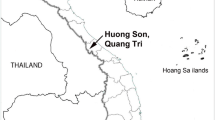Abstract
The life cycle ofBrachylaima ruminae n.sp. (Trematoda: Brachylaimidae), a duodenal parasite of rodents on the Mediterranean island of Formentera (Spain) is elucidated. The new species follows a terrestrial triheteroxenous life cycle. Eggs passed in the faeces of the definitive host must be ingested by a specific first intermediate host, the land snailRumina decollata. Branched cercariogenous sporocysts develop in the digestive gland. Microcercous cercariae come out through the terminal birth pores of the branches. Cercariae shed by the snail are terrestrial, crawling on humid substratum. They contact the second intermediate host, another land snail, principally the speciesR. decollata and less frequently slugs and Helicids. Cercariae enter via the excretory pore and kidney duct to their specific final location, the kidney. Unencysted metacercariae develop in the kidney (also, less frequently, in the pedal glands) to the mature, infective stage. Infective metacercariae infest the definitive host when ingested together with the snail.
Similar content being viewed by others
References
Balozet L (1937a)Brachylaemus suis Mihi 1936, trématode de l'intestin du porc. Rôle pathogene et cycle évolutif. Arch Inst Pasteur Tunis 26:36–67
Balozet L (1937b) Cycle évolutif deBrachylaemus suis L.B. 1936. CR Acad Sci [D] (Paris) 204:622–624
Baylis H (1927) Notes on three little known trematodes. Ann Mag Nat Hirst 19:426–433
Bayssade-Dufour Ch (1979) L'appareil sensoriel des cercaires et la systématique des Trématodes Digénétiques. Mém Mus Nat Hist Nat sér A Zool 113:3–81
Combes C, Bayssade-Dufour Ch, Cassone J (1976) Sur l'impregnation et le montage de cercaires pour l'étude chétotaxique. Ann Parasitol Hum Comp 51:399–400
Dollfus RPh (1935) Sur quelquesBrachylaemus de la faune française récoltés principalement à Richelieu (Indre et Loire). Ann Parasitol Hum Comp 13:52–79
Dollfus RPh (1968) Les Trématodes de l'Histoire Naturelle des Helminthes de Félix Dujardin (1845). Mém Mus Nat Hist Nat nouv sér, sér A Zool 54:119–196+pl I-XLVII
Feliu C, Mas-Coma S, Gállego J (1983) Sobre las helmintofaunas de las especies del géneroRattus Fischer, 1803 (Rodentia: Muridae) en la Península Ibérica. Circ Farm 279:123–132
Jensen DN (1972) The life history ofScaphiostomum pancreaticum McIntosh, 1934 (Trematoda: Brachylaemidae). Can J Zool 50:201–204
Jourdane J, Triquell A (1973) Digènes parasites d'Apodemus sylvaticus (L.) dans la partie orientale des Pyrénées. Description deMacyella apodemi sp. n. Bull Mus Nat Hist Nat Paris 91:351–361
Joyeux Ch, Foley H (1930) Les helminthes deMeriones shawi shawi Rozet dans le nord de l'Algérie. Bull Soc Zool Fr 55:353–374
Joyeux Ch, Baer JG, Timon-David J (1932a) Le développement du TrématodeBrachylaemus (Brachylaemus) nicolli (Witenberg). CR Soc Biol (Paris) 109:464–466
Joyeux Ch, Baer JG, Timon-David J (1932b) Recherches sur le cycle évolutif des Trématodes appartenant au genreBrachylaemus Dujardin (syn.Harmostomum Braun). CR Acad Sci [D] (Paris) 195:972–973
Joyeux Ch, Baer JG, Timon-David J (1934) Recherches sur les Trématodes du genreBrachylaemus Dujardin (syn.Harmostomum Braun). Bull Biol France et Belgique 68:385–418 + 14 pl
Macchioni G (1968) Segnalazione di nuovi molluschi ospiti intermidi diBrachylaima fuscata (Rudolphi, 1819). Riproduzione sperimentale dell'infestione nel colombo e nella tortora. Atti Soc Ital Sci Vet 22:746–749
Mas-Coma S, Esteban JG (1983) Nuevos datos sobre las helmintofaunas parásitas de micromamíferos en las Islas Pitiusas. II. Platelmintos. III. Estado actual de conocimientos. Boll Soc Hist Nat Balears 27:181–194
Mas-Coma S, Feliu C (1977) Contribución al conocimiento de la helmintofauna de micromamíferos ibéricos. IV. Parásitos deApodemus sylvaticus Linnaeus, 1758 (Rodentia: Muridae). Rev Ibér Parasit 37:301–317
Mas-Coma S, Feliu C (1984) Helminthfauna from small mammals (insectivores and rodents) on the Pityusic Islands. In: Kuhbier H, Alcover JA, Guerau d'Arellano Tur C (eds), Biogeography and ecology of the Pityusic Islands, Dr W Junk Publ The Hague, Monographiae Biologicae 52:469–525
Mas-Coma S, Montoliu I, Valero MA (1984) Methodologie d'étude morphométrique de la variabilité intraspécifique chez les Digènes de la famille Brachylaimidae Joyeux et Foley, 1930. Bull Soc Neuchâtel Sc Nat 107:185–195
Montoliu I, Gracenea M, Mas-Coma S (1985) Sobre la detección de la existencia de varias especies deBrachylaima Dujardin, 1843 (Trematoda: Brachylaimidae) de adultos morfológicamente indiferenciables en la isla de Formentera: trascendencia del hallazgo. In: IV Cong Nac Parasit (Tenerife 9–13 Julio), Resumenes de las Comunicaciones: 151
Richard J (1971) La chétotaxie des cercaires. Valeur systématique et phylétique. Mém Mus Nat Hist Nat sér A Zool 67:1–179
Timon David J (1954) Kystes àBrachylaemus chezCyclostoma elegans Müller. Développement expérimental du parasite. CR Soc Biol 148:708–710
Timon-David J (1959) Recherches sur les kystes àBrachylaemus du cyclostome. Ann Parasitol Hum Comp 34:271–287
Ulmer MJ (1949) Sporocyst generations ofPostharmostomum laruei McIntosh, 1934 (Trematoda: Brachylaemidae). J Parasitol 35:22
Ulmer MJ (1951)Postharmostomum helicis (Leidy, 1847) Robinson 1949 (Trematoda), its life history and a revision of the subfamily Brachylaeminae. Parts I and II. Trans Am Microsc Soc 70:189–238 and 319–347
Villella JB (1953) The life history ofEctosiphonus rhomboideus Sinitsin, 1931 (Trematoda: Brachylaematidae) from the short-tailed shrewBlarina brevicauda. J Parasitol 39:21
Villella JB (1954) The life history ofBrachylaima rhomboideum (Sinitsin, 1931) (Trematoda: Brachylaematidae). Dissertation Abst Int 14:745–746
Yamaguti S (1971) Synopsis of Digenetic Trematodes of Vertebrates. Vol I, Keigaku Publ Co, Tokyo
Yamaguti S (1975) A synoptical review of life histories of Digenetic Trematodes of Vertebrates, Keigaku Publ Co, Tokyo
Zdarska Z, Soboleva TN (1980) Scanning electron microscopy of the cercaria and metacercaria ofBrachylaimus aequans (Looss, 1899). Folia Parasitol (Praha) 27:127–130
Author information
Authors and Affiliations
Rights and permissions
About this article
Cite this article
Mas-Coma, S., Montoliu, I. The life cycle ofBrachylaima ruminae n. sp. (Trematoda: Brachylaimidae), a parasite of rodents. Z. Parasitenkd. 72, 739–753 (1986). https://doi.org/10.1007/BF00925095
Accepted:
Issue Date:
DOI: https://doi.org/10.1007/BF00925095




